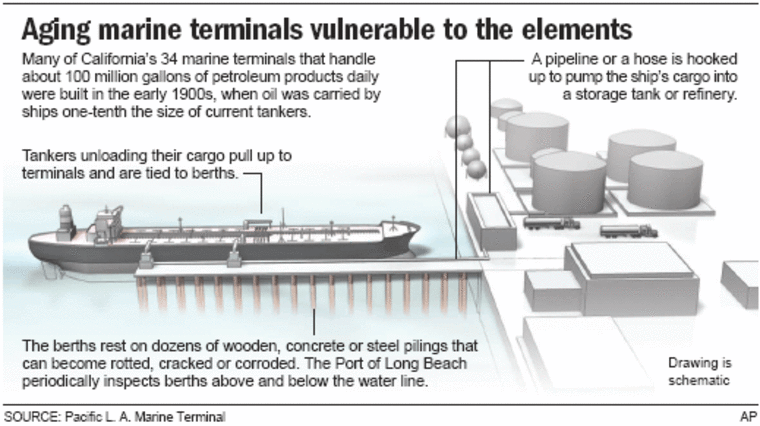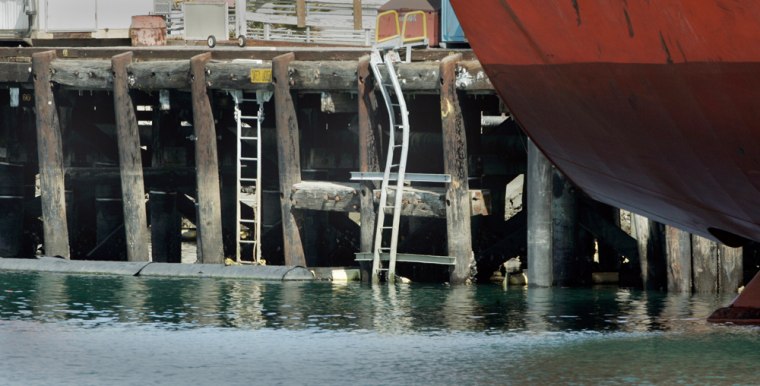A tanker was unloading a highly flammable chemical when the wake from a passing ship pulled the vessel 20 feet from the dock. The tanker’s hoses were stretched almost to the breaking point before the vessel slammed back into its aging berth, splintering more than a dozen beams, state officials say.
That happened last August in the Port of Los Angeles. There was no spill, but the incident focused attention on what state officials say could be an environmental catastrophe in the making.
Many of the marine terminals handling millions of gallons of petroleum products every day in California were built in the early 1900s, when oil was carried by ships one-tenth the size of today’s tankers. And many of them are in disrepair and vulnerable to devastating spills and fires, particularly in the event of an earthquake or other calamity, state officials say.
“The disasters are out there waiting to happen,” said Gary Gregory, chief of the California State Lands Commission’s Marine Facilities Division, which oversees terminal safety.
And terminals in New York, Texas or other parts of the country are not “distinctly better or worse,” said Larry Cunningham, a vice president at the New York-based marine engineering company Halcrow HPA. “I would say there’s nothing unique about the facilities in California.”
California’s 34 marine oil terminals handle about 100 million gallons of petroleum products every day, including gasoline, crude, diesel and lubricating oil.
Working on list of most dangerous
It took the better part of a decade for the State Lands Commission to get the funding and develop first-of-their-kind standards for marine terminals, then two more years to get enforcement power. That occurred last year.
Now the state is starting to take action. It has embarked on an inventory of terminals considered most dangerous. Once that is completed next year, repairs can be ordered. The agency can also recommend fines of as much as $250,000 for violations that go unrepaired.
State officials are refusing to allow ExxonMobil to reopen the berth damaged last summer, even though the pilings have been repaired. The commission says an engineering study should be done to make sure the berth, built in 1922, can handle today’s tankers.
“The incident was a hair away from a major catastrophe,” said Martin Eskijian, an engineering supervisor with the commission. Eskijian likened the repairs to taking two aspirin to fight cancer: “It doesn’t do you a lot of good.”

ExxonMobil questions the need for additional work. Spokesman Brian Dunphy said the berth routinely passed state inspections and has a long history of safe operation.
“When enhancements are made regularly and consistently, there is no reason an older facility cannot be operated safely into the future — whether it be a building such as the Empire State Building, a sports stadium such as the Los Angeles Coliseum, or a marine terminal,” he wrote in an e-mail.
Dunphy blamed the passing ship for the incident. The company wants the commission to require other ships to pass its terminal at a greater distance and more slowly.
Dennis Bolt, a spokesman with the Western State Petroleum Association, an oil industry group, said he knows companies that are dedicated to safety and “have invested tens of millions of dollars to upgrade their docks over the decades.”
Oil companies maintain terminals
Tankers unloading their cargo pull up to terminals and are tied to berths. A pipeline or a hose then is hooked up to pump the ship’s cargo into a storage tank or refinery. The berths rest on dozens of wooden, concrete or steel pilings that can become rotted, cracked or corroded.
In California, the repair of many terminals is the responsibility of the oil companies that hold the leases. Port authorities can also be responsible for repairs.
The Port of Long Beach periodically inspects berths above and below the water line.
“Old doesn’t necessarily mean they’re not kept up,” port spokesman Art Wong said.
Tracy Egoscue, who sits on the state-appointed Oil Spill Technical Advisory Committee, said it could take a long time to get the terminals fixed.
“The example of the Exxon terminal in the L.A. Harbor is a stark example,” she said. “If the world’s richest oil company can’t make the necessary repairs after an accident, then who will?”
